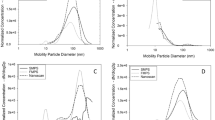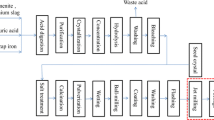Abstract
Nanoparticles are used in many applications because of their novel properties compared to bulk material. A growing number of employees are working with nanomaterials and their exposure to nanoparticles trough inhalation must be evaluated and monitored continuously. However, there is an ongoing debate in the scientific literature about what are the relevant parameters to measure to evaluate exposure to level. In this study, three types of nanoparticles (ammonium sulphate, synthesised TiO2 agglomerates and aerosolised TiO2 powder, modes in a range of 30–140 nm mobility size) were measured with commonly used aerosol measurement instruments: scanning and fast mobility particle sizers (SMPS, FMPS), electrical low pressure impactor (ELPI), condensation particle counter (CPC) together with nanoparticle surface area monitor (NSAM) to achieve information about the interrelations of the outputs of the instruments. In addition, the ease of use of these instruments was evaluated. Differences between the results of different instruments can mainly be attributed to the nature of test particles. For spherical ammonium sulphate nanoparticles, the data from the instruments were in good agreement while larger differences were observed for particles with more complex morphology, the TiO2 agglomerates and powder. For instance, the FMPS showed a smaller particle size, a higher number concentration and a narrower size distribution compared with the SMPS for TiO2 particles. Thus, the type of the nanoparticle was observed to influence the data obtained from these different instruments. Therefore, care and expertise are essential when interpreting results from aerosol measurement instruments to estimate nanoparticle concentrations and properties.






Similar content being viewed by others
References
Asbach C, Fissan H, Stahlmecke TAJ, Pui DYH (2009a) Conceptual limitation and extensions of lung-deposited Nanoparticle Surface Area Monitor (NSAM). J Nanopart Res 11:101–109
Asbach C, Kaminski H, Fissan H, Monz C, Dahmann D, Mülhopt S, Paur HR, Kiesling HJ, Herrmann F, Voetz M, Kuhlbusch TAJ (2009b) Comparison of four mobility particle sizers with different time resolution for stationary exposure measurements. J Nanopart Res 11:1593–1609
Backman U, Lyyränen J, Auvinen A, Jokiniemi J (2009) Portable nanoparticle generator for exposure studies. In: Abstracts of the 4th international conference on nanotechnology—Occupational and Environmental Health 42
Baron PA, Willeke K (2001) Aerosol measurement: principles, technique and applications. Wiley Interscience, New Jersey
Borm PJA, Robbins D, Haubold S, Kuhlbusch T, Fissan H, Donaldson K, Schins R, Stone V, Kreyling W, Lademann J, Krutmann J, Warheit D, Oberdörster E (2006) The potential risk of nanomaterials: a review carried out for ECETOC. Part Fibre Toxicol 3:11
Colvin VL (2003) The potential environmental impact of engineered nanomaterials. Nat Biotechnol 21:1166–1170
Gwinn MR, Vallyathan V (2006) Nanoparticles: health effects—pros and cons. Environ Health Perspect 114:1818–1825
Hinds WC (1999) Aerosol technology: properties, behavior and measurement of airborne particles. John Wiley & Sons, New York
International Commission on Radiological Protection (1994) Human respiratory tract model for radiological protection. Annals of the ICRP publication 66. Elsevier Science Inc, Tarrytown
Jeong C-H, Evans GJ (2009) Inter-comparison of a fast mobility particle sizer and a scanning mobility particle sizer incorporating an ultra fine water-based condensation particle counter. Aerosol Sci Technol 43:364–373
Keskinen J, Pietarinen K, Lehtimäki M (1992) Electrical low pressure impactor. J Aerosol Sci 23:353–360
Lyyränen J, Jokiniemi J, Kauppinen EIK, Backman U, Vesala H (2004) Comparison of different dilution methods for measuring diesel particle emissions. Aerosol Sci Technol 38:12–23
Maricq MM, Podsiadlik DH, Chase RE (2000) Size distributions of motor vehicle exhaust PM: a comparison between ELPI and SMPS measurements. Aerosol Sci Technol 33:239–260
Marjamäki M, Keskinen J (2004) Effect of impaction plate roughness and porosity on collection efficiency. J Aerosol Sci 35:301–308
Marjamäki M, Ntziachristos L, Virtanen A, Ristimäki J, Keskinen J, Moisio M, Palonen M, Lappi M (2002) Electrical filter stage for the ELPI. SAE Technical paper ser 2002-01-0055
Miettinen M, Riikonen J, Tapper U, Backman U, Joutsensaari J, Auvinen A, Lehto V-P, Jokiniemi J (2009) Development of highly controlled gas-phase nanoparticle generator for inhalation exposure studies. Hum Exp Toxicol 28:413–419
Oberdörster G, Oberdörster E, Oberdörster J (2005) Nanotoxicology: an emerging discipline evolving from studies of ultrafine particles. Environ Health Perspect 113:823–839
Shin WG, Pui DYH, Fissan H, Neumann S, Trampe A (2007) Calibration and numerical simulation of nanoparticle surface area monitor (TSI model 3550 NSAM). J Nanopart Res 9:61–69
Shin WG, Wang W, Mertler M, Sachweh B, Fissan H, Pui DYH (2010) The effect of particle morphology on unipolar diffusion charging of nanoparticle agglomerates in the transition regime. J Aerosol Sci 41:975–986
Tissari J, Raunemaa T, Jokiniemi J, Sippula O, Hytönen K, Linna V, Oravainen H, Pyykönen J, Tuomi S, Vesterinen R, Taipale R, Kolsi A, Nuutinen I, Kouki J, Vuorio K (5/2005) In: Tissari J (ed) Particle emissions in small scale wood combustion. Publ ser of Department of Environmental Science, University of Eastern Finland
TSI Incorporated (2010) Measuring Nanoparticle Exposure Application note NSAM-00. http://www.tsi.com/uploadedFiles/Product_Information/Literature/Application_Notes/NSAM-001appnote.pdf. Accessed 27 June 2011
Virtanen A, Joutsensaari J, Koop T, Kannosto J, Yli-Pirilä P, Leskinen J, Mäkelä JM, Holopainen JK, Pöschl U, Kulmala M, Worsnop DR, Laaksonen A (2010) An amorphous solid state of biogenic secondary organic aerosol particles. Nature 467:824–827
Acknowledgments
This research was supported by the Finnish Funding Agency for Technology and Innovation (TEKES), Sachtleben Pigments Ltd, Beneq Ltd, Amroy, the Federation of Finnish Technology Industries, Technical Research Centre of Finland, Finnish Institute of Occupational Health and University of Eastern Finland (the strategic funding of the University of Eastern Finland for the project: Novel nanostructured materials for pharmaceutical, biomedical and environmental applications). The authors would like to greatly acknowledge Mika Ihalainen M.Sc. from University of Eastern Finland for his significant help during the data analysis. In addition, the authors would like to acknowledge Tommi Karhunen M.Phys. for useful comments.
Author information
Authors and Affiliations
Corresponding author
Rights and permissions
About this article
Cite this article
Leskinen, J., Joutsensaari, J., Lyyränen, J. et al. Comparison of nanoparticle measurement instruments for occupational health applications. J Nanopart Res 14, 718 (2012). https://doi.org/10.1007/s11051-012-0718-7
Received:
Accepted:
Published:
DOI: https://doi.org/10.1007/s11051-012-0718-7




